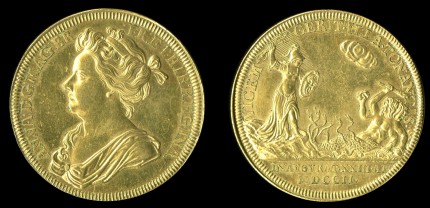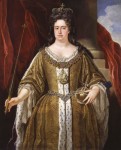
Oxford University PhD student James Hone has discovered a manuscript in the National Archives at Kew that proves Isaac Newton personally designed the coronation medal commemorating the accession of Queen Anne in 1702. Newton was Master of the Mint at the time, but before this discovery scholars believed that the medal was designed by court painter Sir Godfrey Kneller.
[T]he notes show Newton switching ideas from science to maths, classical history, politics and literature.
“It tells us that Newton didn’t conceive of himself as a scientist, but a master of lots of trades. The understanding of him as a great scientist is a later imposition, he would have seen himself more as a public servant.”
Finding a manuscript in Newton’s own hand complete with sketches and explanations of the metaphors woven into the design lends new insight into the man, his work at the mint and the seething cauldron of politics bubbling around Queen Anne’s coronation.
Official commemorative medals were struck for every coronation of a Stuart monarch. There were gold versions to hand out to the peers and diplomats attending the coronation and cheaper silver versions to throw into the crowds gathered at Westminster Abbey. Original documentation about the design and production of most of the Stuart tokens has not survived. That makes the Isaac Newton papers on the creation of the 1702 medal all the more significant.
Hone was doing research for the Stuart Successions Project, a joint study by Exeter University and Oxford University of printed material written during and about the succession crises in Britain between 1603 and 1702, when he came across a set of manuscripts from Newton’s time as Master of the Mint. One of them was a 50-page document that, judging from the completely rusted clasp keeping the pages together, hadn’t been read for years. The manuscript detailed the design of the first coronation medal and other prospective medals as well.
 Newton was in his mid-50s when he was appointed Warden of the Royal Mint in 1696 during the reign of King William III. He was enlisted by Secretary to the Treasury William Lowndes to help in the Great Recoinage of 1696, an attempt by the government to solve a currency crisis by taking old, badly clipped silver coins and counterfeits out of circulation. Newton committed to the task with characteristic vigor, going undercover in taverns and dark alleys to gather information on counterfeiters. He personally interrogated suspects and witnesses and prosecuted dozens, securing convictions in 28 cases. He also helped establish the Bank of England as ordered by Acts of Parliament.
Newton was in his mid-50s when he was appointed Warden of the Royal Mint in 1696 during the reign of King William III. He was enlisted by Secretary to the Treasury William Lowndes to help in the Great Recoinage of 1696, an attempt by the government to solve a currency crisis by taking old, badly clipped silver coins and counterfeits out of circulation. Newton committed to the task with characteristic vigor, going undercover in taverns and dark alleys to gather information on counterfeiters. He personally interrogated suspects and witnesses and prosecuted dozens, securing convictions in 28 cases. He also helped establish the Bank of England as ordered by Acts of Parliament.
He was appointed Master of the Mint in 1699, and even though both the mint positions he held were widely considered sinecures, Isaac Newton took the second one as seriously as he had the first. He retired as Member of Parliament for the Cambridge University constituency to dedicate himself to the job. Little surprise, then, that he was writing 50-page treatises on commemorative medals when his predecessors had left that sort of thing to Mint minions. He put his extensive knowledge of mythology and allegory to work crafting a doozy of a propaganda piece.
The obverse of the medal is profile of Queen Anne similar to what you’d find on the regular coinage inscribed “ANNA D.G. MAG. BR. FRA. ET. HIB REGINA” (“Anne, by the grace of God, Queen of Great Britain, France and Ireland”). The reverse is the juicy bit. Anne is depicted as the Greek warrior goddess Pallas Athena standing on a hill with the rays of the sun shining down upon her. She holds three bolts of lightning upraised in her right hand and her aegis in the left. At her feet is an aggressive monster with two heads, four arms (two of them hold clubs, the other two rocks) and eight snakes in place of legs. This side is inscribed “VICEM GERIT ILLA TONANTIS” or “She is the Thunderer’s viceregent” across the top and “INAUGURAT XXIII AP MDCCII” (“Crowned April 23, 1702”) across the bottom.
The multi-headed serpent element suggests this monster is the Hydra, classical symbol of a complex and die-hard enemy that springs two new heads for every one you cut off. Before now scholars have thought the monster represented a domestic faction opposed to Anne’s rule. Hone discovered that Newton had a whole other think going.
But Newton, in his own notes on the design, describes it as a symbol of “any Enemy with which Her Majesty hath or may have War”. In other words, the monster presents the double threat posed by Louis XIV and James Francis Edward Stuart [Anne’s exiled half-brother, the Catholic son of James II], the Old Pretender. The motto looks back to William and Mary. By describing Anne as a “Thunderer”, Newton explains that he was alluding to the coronation medal of 1689, which likewise portrayed William as a thundering Jupiter. In a sentence, Newton explains that the coronation medal “signifies that her Majesty continues the scene of the last reign”.
The messages of the medal were not lost at the time. Some of William’s allies used the medal to suggest that Anne was William redivivus. William’s Tory enemies, on the other hand, considered it a potentially seditious object. The High Tory Vice Chancellor of Oxford even banned students from discussing the medal in their panegyrics to the new queen! This medal, it seems, had political bite.
 The medal’s depiction of Anne as the warrior queen continuing where King William had left off seems to have made people nervous in other ways as well. She never again appeared as a fighter. There were two other medals cast after this one in 1702. The second featured her profile on the obverse and her husband Prince George of Denmark on the reverse. The third had the usual profile obverse and a European town under siege on the reverse. The inscription says “VIRES ANIMUMQUE MINISTRAT,” meaning “She gives strength and courage.” Gone was the warrior goddess vanquishing the country’s enemies with her terrible power of the thunderbolt. In a matter of months her she was whittled down into an inspiration, a sort of spiritual Betty Grable pin-up shoring up troop morale. That shift became permanent, and it’s very noticeable because there were multiple issues of Queen Anne commemorative medals with battle scenes on the reverse.
The medal’s depiction of Anne as the warrior queen continuing where King William had left off seems to have made people nervous in other ways as well. She never again appeared as a fighter. There were two other medals cast after this one in 1702. The second featured her profile on the obverse and her husband Prince George of Denmark on the reverse. The third had the usual profile obverse and a European town under siege on the reverse. The inscription says “VIRES ANIMUMQUE MINISTRAT,” meaning “She gives strength and courage.” Gone was the warrior goddess vanquishing the country’s enemies with her terrible power of the thunderbolt. In a matter of months her she was whittled down into an inspiration, a sort of spiritual Betty Grable pin-up shoring up troop morale. That shift became permanent, and it’s very noticeable because there were multiple issues of Queen Anne commemorative medals with battle scenes on the reverse.
Hone thinks Newton’s work at the mint may have played a part in his knighthood. Queen Anne knighted Isaac Newton in 1705, three years to the month after her coronation, during her visit to Cambridge. He was running for Cambridge MP at the time and the election was a month away, so historians generally believe the knighting was a political gesture rather than recognition of his work for the crown or his scientific accomplishments. Newton was only the second scientist ever knighted. Sir Francis Bacon was the first to receive the honor in 1603.